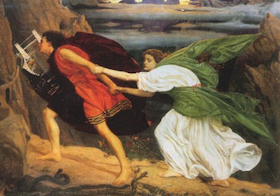
It might have taken four centuries, but now Monteverdi's 1607 Orfeo will have its French-Indian production next week in New Delhi, to be followed by a performance in Paris on Oct. 5. It is named Orfeo, Crossing the Ganges.
In this version, Orfeo provokes Shiva's wrath when he marries Eurydice. His quest to find Eurydice involves crossing the Ganges to Varanasi.
"The story has been given an Indian context," says Francis Wacziarg, founder of Neemrana Music Foundation, and producer of the opera.
"The question we asked ourselves was why does Eurydice sing so little. Maybe she was from a culture that prevented her from expressing herself in music. Just like the Indian bride who is not allowed to sing at her wedding. And maybe Orfeo was from a culture different from hers. That led us to base Eurydice's world in India," says Aude Priya, a veteran of many international opera productions, who essays the role of Proserpine in the opera.

Photo by R. Shivaji Rao
Eurydice is given an additional voice with the casting of Odissi dancer Arushi Mudgal. Odissi is the oldest among India's eight main ancient dance forms. The others are Bharatanatyam, Kathak, Kathakali, Kuchipudi, Manipuri, Mohiniyattam, and Sattriya.
"It seems like such a simple condition to not look back. So why does Orfeo turn back? Maybe the root of it lies in the fact that he doesn't understand her world and finds it hard to adjust to it," says Priya.
Two years in the making, the production involves 50 artists, including instrumentalists from the Akadêmia and seven members of the Neemrana vocal ensemble, a Hungarian tenor, two artists from Argentina, one from Brazil, and others from Czechoslovakia, Belgium and Germany. Rare instruments which were used in Monteverdi's era — theorbo, viola de gamba, organ, harpsichord — have been flown in especially for the performance.

